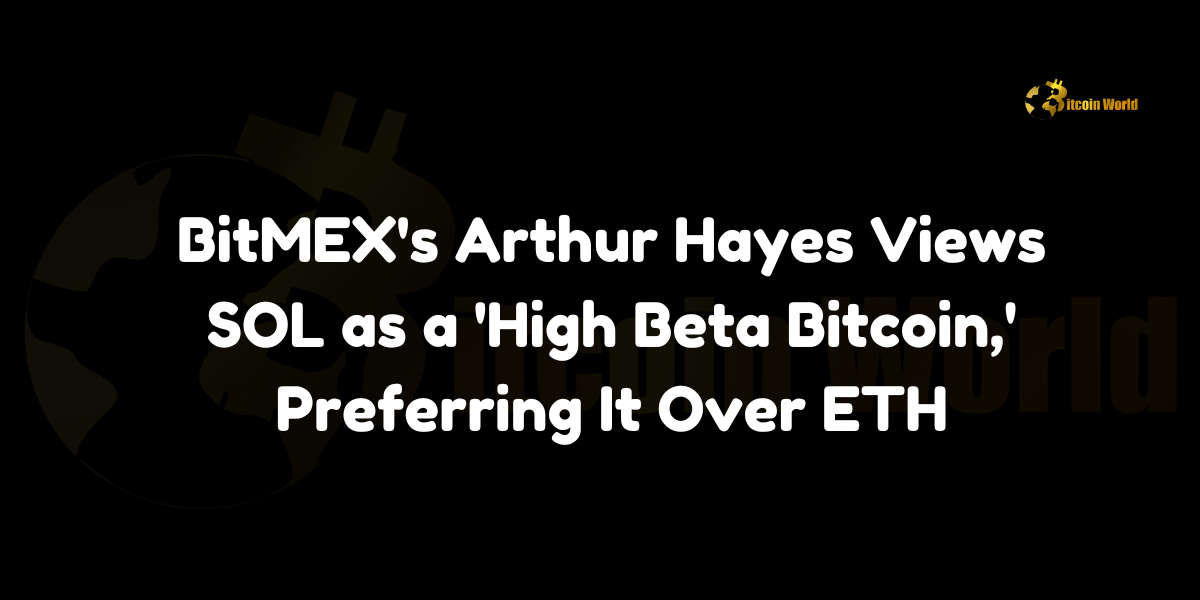BitMEX’s Arthur Hayes Views SOL as a ‘High Beta Bitcoin,’ Preferring It Over ETH
In a revealing discussion on the Unchained podcast, Arthur Hayes, co-founder of the prominent crypto exchange BitMEX, shared his distinctive perspectives on the cryptocurrency landscape. Hayes characterized Solana (SOL) as a “high beta Bitcoin” and expressed a clear preference for SOL over Ethereum (ETH). His insights provide valuable considerations for investors navigating the rapidly evolving crypto market, especially with the U.S. presidential election looming and significant monetary policy decisions on the horizon.
Introduction to Arthur Hayes’ Crypto Insights
Who is Arthur Hayes?
Arthur Hayes is a well-known figure in the cryptocurrency industry, recognized for co-founding BitMEX, a leading crypto exchange platform. Hayes is renowned for his outspoken views on market dynamics, regulatory developments, and the comparative performance of various cryptocurrencies.
Context of the Discussion
During the recent episode of the Unchained podcast, Hayes delved into his analysis of Solana (SOL) and Ethereum (ETH), providing a comparative evaluation that highlights SOL’s potential advantages in the current market environment.
Solana (SOL) as a ‘High Beta Bitcoin’
Understanding ‘High Beta’
In financial terms, beta measures the volatility or systematic risk of a security or portfolio compared to the market as a whole. A high beta asset is more volatile than the market, meaning it can offer higher returns in bullish conditions but also poses greater risk during downturns. By labeling SOL as a “high beta Bitcoin,” Hayes suggests that SOL may offer amplified returns relative to Bitcoin (BTC) in rising markets.
Why Solana?
Solana (SOL) has gained traction for its high throughput and low transaction costs, positioning itself as a scalable solution for decentralized applications (dApps) and decentralized finance (DeFi) projects. Hayes points to several key attributes:
Rapid Market Response: SOL’s ability to react quickly to market changes allows it to capitalize on bullish trends more effectively than BTC or ETH.
High Liquidity: Enhanced liquidity facilitates smoother transactions and reduces the impact of large trades on SOL’s price.
Technological Advancements: Solana’s unique consensus mechanism and high-performance blockchain infrastructure contribute to its competitive edge.
Ethereum (ETH) and Its Current Challenges
Ethereum’s Performance
Ethereum (ETH), while being the second-largest cryptocurrency by market capitalization, has recently faced challenges that Hayes criticizes:
Slower Transaction Speeds: Compared to Solana, Ethereum has been perceived as “too slow,” impacting its scalability and user experience.
Network Congestion: High demand has led to increased gas fees and slower transaction processing times, making it less attractive for users and developers.
Need for a Narrative Shift: Hayes emphasizes that Ethereum requires a significant narrative change to overcome its performance issues and regain investor confidence.
Comparative Beta Analysis
Hayes contrasts ETH’s beta with SOL’s, stating that ETH exhibits an “equal beta” to BTC or even slightly lower. This implies that ETH’s volatility and potential for returns are on par with or less than Bitcoin, reducing its attractiveness in Hayes’ investment strategy focused on high-beta assets.
Bitcoin (BTC) in the Current Market
BTC’s Recent Performance
Bitcoin (BTC) continues to be the flagship cryptocurrency, but Hayes notes that its performance is highly influenced by broader market sentiments and external factors, such as regulatory decisions and macroeconomic indicators.
Impact of Federal Reserve’s Monetary Policy
With the U.S. presidential election approaching, Hayes underscores the pivotal role of the Federal Reserve’s decision on interest rates scheduled for November 7. The potential easing of monetary policy could significantly influence BTC’s performance:
Interest Rate Cuts: If the Fed implements rate cuts, it may lead to increased liquidity in the market, potentially boosting BTC’s price.
High-Beta Assets Advantage: In an environment of monetary easing and rising BTC prices, high-beta assets like SOL are strategically favorable, offering amplified returns compared to BTC itself.
Strategic Investment Considerations
Favoring High-Beta Assets
Hayes advocates for investing in high-beta assets like SOL during periods of market optimism and potential liquidity increases. This strategy aims to maximize returns by leveraging the heightened volatility and responsiveness of SOL to market movements.
Diversification and Risk Management
While favoring SOL, Hayes acknowledges the importance of diversification and robust risk management practices, especially in the inherently volatile cryptocurrency market. Balancing high-beta investments with more stable assets can mitigate potential losses during market downturns.
Expert Opinions and Market Analysis
Dr. Emily Carter, Blockchain Analyst
“Solana’s high throughput and low fees make it a compelling alternative to Ethereum, especially in a rising market. Arthur Hayes’ comparison of SOL to high-beta Bitcoin highlights its potential for significant returns, though investors should remain mindful of the associated risks.”
Mark Thompson, Financial Strategist
“Hayes’ preference for SOL over ETH underscores a strategic shift towards assets that offer greater agility and responsiveness in bullish markets. However, it’s crucial for investors to consider the broader market conditions and regulatory landscape when adopting such strategies.”
Sarah Lee, Cryptocurrency Researcher
“The characterization of Solana as a high-beta asset relative to Bitcoin offers an interesting perspective for portfolio diversification. Solana’s technical advantages position it well, but its performance will continue to be influenced by market sentiment and macroeconomic factors.”
Future Outlook for Solana and Ethereum
Solana’s Growth Trajectory
Solana is poised for continued growth, driven by its technological advancements and expanding ecosystem. Upcoming developments, partnerships, and increased adoption of Solana-based projects could further enhance its market position and investment appeal.
Ethereum’s Path to Improvement
Ethereum’s roadmap, including ongoing upgrades and potential scalability solutions, aims to address its current performance challenges. A successful narrative shift and technological improvements could rejuvenate Ethereum’s standing in the market.
Monitoring Federal Reserve Decisions
The upcoming Federal Reserve’s interest rate decision will be a critical factor influencing the cryptocurrency market. Investors should closely monitor these developments to adjust their strategies accordingly, balancing high-beta investments with risk management practices.
Conclusion
Arthur Hayes’ endorsement of Solana (SOL) as a “high beta Bitcoin” reflects a strategic preference for high-volatility assets that can capitalize on bullish market conditions. In contrast, his critique of Ethereum (ETH) highlights the need for significant improvements to regain its competitive edge. As the cryptocurrency market navigates through regulatory challenges and macroeconomic influences, Hayes’ insights offer valuable guidance for investors seeking to optimize their portfolios with high-beta assets like SOL.
With the U.S. presidential election approaching and critical monetary policy decisions imminent, the dynamics of the crypto market are set to undergo significant shifts. Investors must remain vigilant, leveraging expert analyses and strategic investment approaches to navigate the evolving landscape effectively.
To stay updated on the latest developments in cryptocurrency investments and market strategies, explore our article on latest news, where we cover significant events and their impact on the digital asset ecosystem.





